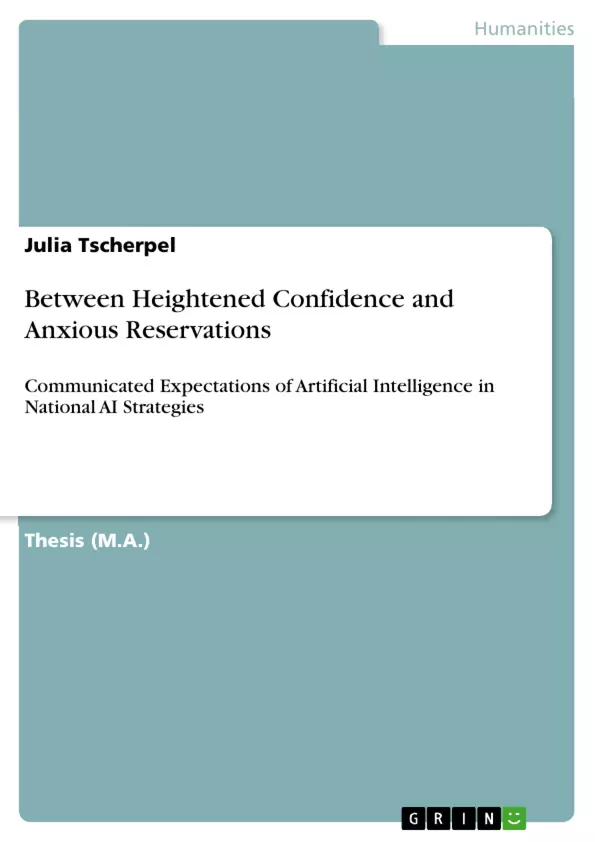The thesis draws on the field of the sociology of expectations to highlight the role of shared societal expectations of AI in the diffusion of new technological innovation. It adds to the list of globally shared societal expectations of AI that are described in past research and publications, and analyses the communication of these expectations in twelve National AI Strategies. Lending from communication studies, lexical units that indicate positive or negative expectations regarding this disruptive technology are sought out to arrange countries according to their country-specific vision of AI. They are grouped according to whether they distribute a confident, reserved, or impartial vision of AI.
Inhaltsverzeichnis (Table of Contents)
- Introduction
- The State of Research
- A Short History of AI Development
- The Role of Expectations in the Innovation Process of AI
- Introduction to the Sociology of Expectations
- Functions of Expectations in the Societal Discourse
- Performativity
- Normativity
- Factors Influencing Societal Expectations
- Culture
- Media
- Institutional Factors
- Unifying Expectations Through Government Communication
- Repercussions of Message Sidedness in Government Communication
- Design and Method
- Qualitative Content Analysis for the Analysis of Strategic Policy Papers
- Choice of National AI Strategies
- Procedure of the Analysis: Category Formation
- Procedure of the Analysis: Indicating Lexical Units
- Grouping of National AI Strategies: Confident, Reserved, Impartial Perspective
- Quality of the Analysis
- Findings
- Deduced Expectation-Categories from the Literature
- Positive Expectations
- Negative Expectations
- Induced Expectation-Categories from the National AI Strategies
- Positive Expectations
- Negative Expectations
- Evaluation of Communicated Expectations in the National AI Strategies
- Global Positive Expectation-Categories
- Global Negative Expectation-Categories
- Country-Specific Expectation-Categories
- Country-Specific Communication of Expectations
- Concluding Assessment and Grouping of the National AI Strategies
- Deduced Expectation-Categories from the Literature
Zielsetzung und Themenschwerpunkte (Objectives and Key Themes)
This thesis explores the role of shared societal expectations of AI in the diffusion of new technological innovation, drawing upon the field of sociology of expectations. The study aims to identify and analyze the communication of these expectations in twelve National AI Strategies, building upon previous research on global societal expectations of AI.- The role of societal expectations in the adoption and diffusion of AI innovation
- Analyzing the communication of expectations about AI in national policy documents
- Identifying and classifying different perspectives on AI across national AI strategies
- Exploring the impact of communication strategies on the public's understanding of AI
- The potential for AI to shape societal norms and values
Zusammenfassung der Kapitel (Chapter Summaries)
- Introduction: This chapter sets the stage by introducing the ongoing debate surrounding Artificial Intelligence (AI) and its potential impact on society. It emphasizes the need to understand public sentiment and expectations towards AI, especially in the context of a global AI arms race. The chapter also provides a general definition of AI and highlights the distinction between "weak" and "strong" AI.
- The State of Research: This chapter presents a critical review of existing research on societal expectations of AI. It examines previous studies on global expectations and highlights the need for further research on national-level perspectives.
- A Short History of AI Development: This chapter provides a brief historical overview of AI development, tracing its origins and key milestones. It highlights the evolution of AI technologies and the changing nature of public discourse surrounding them.
- The Role of Expectations in the Innovation Process of AI: This chapter delves into the theoretical framework of the sociology of expectations. It explores the functions of expectations in shaping societal discourse and the factors that influence these expectations, including cultural, media, and institutional influences. It also examines the role of government communication in shaping public expectations of AI.
- Design and Method: This chapter outlines the research methodology employed in the study. It describes the use of qualitative content analysis to analyze national AI strategies. It also explains the selection of specific national AI strategies for analysis and the process of identifying and categorizing key lexical units that indicate expectations regarding AI.
- Findings: This chapter presents the findings of the analysis, including a categorization of expectations identified from the literature and from the national AI strategies. It examines the global and country-specific perspectives on AI and evaluates the communication of expectations within the national AI strategies.
Schlüsselwörter (Keywords)
This study focuses on the intersection of sociology of expectations, communication studies, and artificial intelligence (AI). The research investigates the communication of societal expectations about AI within the context of national AI strategies. Key concepts include: societal expectations, AI diffusion, innovation, government communication, national AI strategies, content analysis, and the performativity and normativity of expectations.- Quote paper
- Julia Tscherpel (Author), 2021, Between Heightened Confidence and Anxious Reservations, Munich, GRIN Verlag, https://www.grin.com/document/1357471



